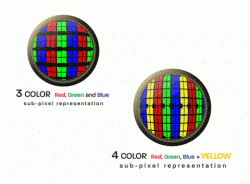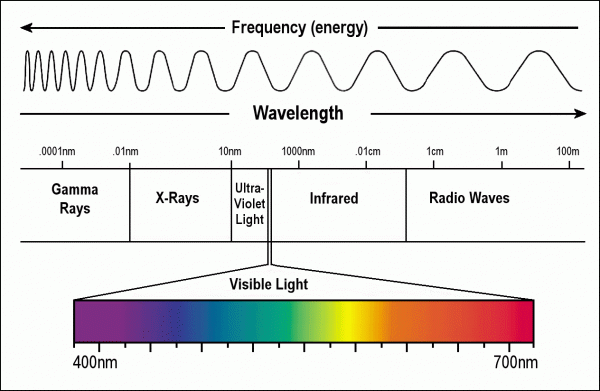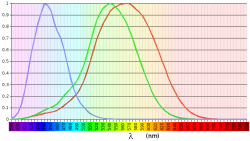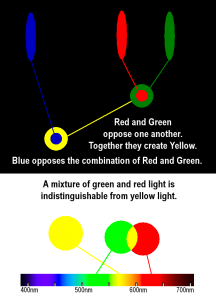BS for George Takei Fans and Consumers
Confession: I adore George Takei. This post isn’t about George Takei. It’s about a gig of his.
George Takei is the newest spokesperson for Sharp, selling a product called “Quattron Quad Pixel Technology”. The product claims that the addition of a yellow filter enables the television to display “never-before-seen colors”.
Absurd. There are no “never-before-seen colors” because color, by definition, must be seen to exist. It is not a property of objects or even light, but the perception of light and its properties.
So, let’s assume that they meant what George says in the commercial: that it displays color you can’t see with your TV’s 3-color technology.
Still very difficult to believe. The current RGB system produces more than 16 million colors, many of which are indistinguishable from one another already, so this seems a bit dubious.
I looked around to see what others are saying about it and found very little. A discussion on gagetynews.com caught my eye, though.
In it the author quotes a neuroscientist named Jack Lewis (who is apparently a UK version of Dr. Oz for the brain) as saying,
A key mechanism of perceiving colour involves comparing levels of red versus green light and blue versus yellow light, which all happens in a special layer of neurons within the retina. The addition of the yellow sub-pixel (to the standard red, green and blue) in this product creates so many new colour tones that the new technology Sharp is using to create images is mimicking critical features of the brain’s visual system. This could ultimately make us feel more involved in things we watch on TV, whether it’s playing a video game with your mates, cheering on your team or watching the latest action thriller.
Well, the first sentence is correct. The rest is hogwash.
First, the retina is in the eye not the brain. One would think that would be covered in neuroscientist school.
Second, what evidence is there to support the statement that mimicking features of the brain, or even seeing an image more clearly, makes us feel “more involved in things we watch”?
Let me answer that: none. Absolutely none. What does that even mean, anyway?

http://www.sharpusa.com/ForHome/HomeEntertainment/LCDTVs/WhatIsQuattron.aspx
How it works
The color of each pixel in an LCD monitor is produced by varying the amount of light shined through each of three sub-pixels each with a red, green, or blue filter. The amount of each determines the color the pixel will ultimately display.
The Quattron monitor involves four sub-pixels: red, green, blue, and yellow. Sharp claims that the addition of a yellow sub-pixel allows the production of more colors than the standard RGB system.
Why I think this claim is just silly
Well, let’s start with the initial statement:
At Sharp, our goal is to reproduce every color in the world on TV.
Color is in the mind, not the world.
Color is a perception, not a property of objects or anything else in the environment. “Reproducing colors” really means reproducing combinations of wavelengths and intensities of light, which our brain interprets as differences in color. An explanation of this is below.
Color is not discrete.
There are certainly limits to our ability to detect differences among colors, but color itself is not a discrete variable. Wavelength can be measured by nanometer, but there is a difference between 451 and 451.1 of these nanometers. There is a difference between 451.1 and 451.11 as well. This variable is continuous and our perception of each does not follow an algorithm. The firing of neurons is only somewhat predictable; it is a matter of probabilities, not certainties.
It is also much more complicated than “see color, perceive color”.
For example, we can distinguish among light samples which differ in wavelength by 2 to 6 nm, depending on placement in the spectrum. This difference is called the “Just Noticeable Difference” (JND). However, the JND differs among individuals. In fact, the distribution of hue perception across wavelengths differs among individuals somewhat.
The point here is that there is not a definitive number of colors in the world or even in the mind.
The human visual system will not know the difference
What follows is a very watered-down version of human color vision, but I would be happy to recommend some excellent texts on the topic if you leave a comment here or email me.

Electromagnetic energy spans a spectrum from gamma rays to radio waves and includes a range we humans sense with our eyes. We call that range the visible light spectrum.
When electromagnetic energy with a wavelength in the visual light spectrum enters the human eye, photons are “caught” by sensors at the back of the retina called rods and cones. These receptors are specialized neurons which fire (when photon absorption is sufficient) and send signals to other neurons.
The number of these receptors that fire allow us to determine the intensity of light (how much light there is). Three of the four kinds of receptors allow us to distinguish among wavelengths of light. The probability of firing for each cone depends on wavelength, with one cone most likely to fire if the wavelength is approximately 420nm, another at approximately 530nm, and the third at approximately 565nm. This is, of course, on average.
These cones are sometimes referred to as blue, green, and red cones, respectively, due to the perception each produces, but since the perceptions are not exactly blue, green, and red, most researchers prefer “s” for short wavelength, “m” for medium, and “l” for long. The responses of these three cones result in all of the colors we perceive by mixing in different amounts, much like the three primaries of pigment (red, yellow, and blue) are combined.
So, what about 4-color separation as a printing process? The CYMK printing process mixes ink primaries of cyan, yellow, and magenta in different amounts to produce millions of colors. The “K” in the process refers to black. Instead of mixing the three ink colors, black ink is used. One advantage of this practice is cost efficiency. Thus, the fact that CYMK is considered a 4-color process does not make it comparable to this “Quattron” process.
Why do we see four unique hues?
 Layers of neurons in the retina converge to form a set of opponencies. Red and green oppose one another, then the combination of red and green cones converge to produce a yellow opponent for blue. In color matching experiments, participants are given a circle of light at a wavelength perceived as yellow. Then they are given another circle in which wavelengths perceived as red and green may be mixed. When they are mixed in equal parts, the circles appear to match although they are quite different in physical properties.
Layers of neurons in the retina converge to form a set of opponencies. Red and green oppose one another, then the combination of red and green cones converge to produce a yellow opponent for blue. In color matching experiments, participants are given a circle of light at a wavelength perceived as yellow. Then they are given another circle in which wavelengths perceived as red and green may be mixed. When they are mixed in equal parts, the circles appear to match although they are quite different in physical properties.
So, the human visual system cannot distinguish between yellow light and a mixture of green and red light. How, then, are we to tell the difference between a pixel produced by a yellow filter and one produced by a mixture of red and green filters?
Even if we could tell the difference between yellow light and a red/green mixture, the Quattron system mixes the color at the sub-pixel level. The color of the pixel is the same in either case.
So what can the Quattron system do?
Much like the K in CYMK, the Quattron system may be more energy efficient by allowing the use of yellow in the place of equal parts red and green light. Sharp claims:
When combined with Sharp’s 1080p X-Gen LCD panel, which incorporates UV2A Technology, the displays offer dramatic reduction in energy consumption compared with conventional fluorescent-backlight LCD TVs.
With four sub-pixels to mix, more variations in wavelength/intensity mixtures may be produced which, technically, means that more shades are produced. However, if this is the case, the ability of the human visual system to differentiate among them is questionable at best. So, it may be able to display more colors, but does it matter? I think not.




It probably just has a different color gamut than a standard RGB TV. So technically it *can* display more colors than a standard TV getting a CIE-gamut compliant NTSC signal could.
Dunno if most people would notice, though.
Disclaimer: I was not a tcomm major, but my roommate in college was. I only care about CMYK color gamut for offset presses, and making sure my monitor doesn’t show me colors I can’t reproduce in print when I’m doing color work.
“Illegal NTSC colors” is all about this: http://www.digitalgypsy.com/vfxlog/archives/2005/03/tip-of-the-week-ntsc.php
[…] Everywhere: Fun Does Not Sell Smarts ICBS Everywhere: BS for George Takei Fans and Consumers ICBS Everywhere: There Must Be an Idiom ICBS Everywhere: Narcissism + Incompetence = Ignorance and […]
[…] Everywhere: Fun Does Not Sell Smarts ICBS Everywhere: BS for George Takei Fans and Consumers ICBS Everywhere: There Must Be an Idiom ICBS Everywhere: Narcissism + Incompetence = Ignorance and […]
[…] Everywhere: Fun Does Not Sell Smarts ICBS Everywhere: BS for George Takei Fans and Consumers ICBS Everywhere: There Must Be an Idiom ICBS Everywhere: Narcissism + Incompetence = Ignorance and […]
[…] Everywhere: Fun Does Not Sell Smarts ICBS Everywhere: BS for George Takei Fans and Consumers ICBS Everywhere: There Must Be an Idiom ICBS Everywhere: Narcissism + Incompetence = Ignorance and […]